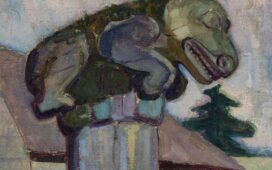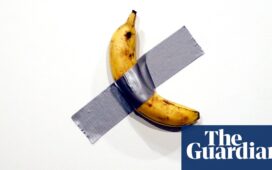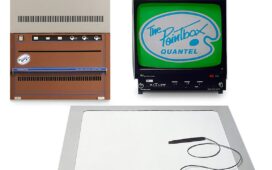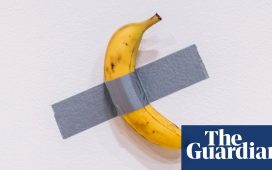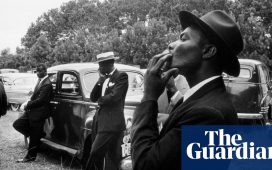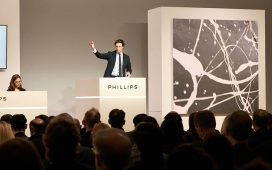Christie’s auctioneer Jussi Pylkkänen sells Jean-Michel Basquiat’s Four Big (1982)
Courtesy of Christie’s
Friday night of Frieze Week is the graveyard slot for auctions and, with no Sotheby’s-style Banksy thrill, Christie’s evening sale of Post War and Contemporary art was a plodder—but key works still performed and the Thinking Italian sale that followed rounded numbers off nicely.
The £54m (£64.5m with fees) total was safely within the pre-sale estimate of £52.4m-£73.8m, but down from last year’s £71.1m—though remember there were only two post war and contemporary sales last year, but Christie’s reintroduced the London July sale this year. Add in the £20m (£24.6m with fees) from the Italian lots at the rear end of the sale and the total was a healthy £74.3m (£89m with fees). Worth the effort then.
A bit of a slog
Given that Christie’s had already held the sale of Jeremy Lancaster’s collection earlier in the week, last night’s sale relied on offerings from two consignments that are being spread throughout multiple sales; the Belgian Mathys-Colle Collection and that of the UniCredit Group. The big name artists were all there but only seven works had a lower estimate over £3m.
The top seller of the night was Jean-Michel Basquiat’s Four Big (1982), which Cristian Albu, Christie’s co-head of the Post-War and Contemporary Art, Europe department describes as having: “All the elements you would want from the artist”. It sold for just under its £7.5m-£9.5m estimate, at £7.4m (£8.6m with fees), reportedly to Aquavella Gallery.
Sigmar Polke’s Alpenveilchen/Flowers (1967) sold for £4.8m (£5.6m with fees; estimate £5m-£7m) and four lots by Gerhard Richter sold well. His haunting (Bride and Groom (blue)) from 1966 went for a £2.6m (£3.1m with fees) to Anthony Grant; Wiese (Meadow, 1983) for £2.8m (£3.4m with fees); Abstraktes Bild (1984) for £6m (£7m with fees) and 7.3.86 (1986) to the London advisers Beaumont Nathan, for £880,000 (£1m with fees).
There were records set by Roman Opalka’s 1965/1—Detail 1330516-1348651 (1965), which made a record for a single panel painting by the French-Polish artist, and the minimalist Bob Law at £65,000. On the flip side, there were a few passes, including a Mark Tansey estimated at £1.2m-£1.8m, while a work by Roy Lichtenstein with a £3m-£5m estimate was withdrawn.
Christie’s £54m post war and contemporary art evening sale was 24% down on the total in 2018, according to ArtTactic
Courtesy of ArtTactic
Rising stars
The closest the room came to a buzz came was with four lots nestled into the middle of the sale, by the fresher names of the night.
Numerous phones and a persistent online bidder pushed Nicolas Party’s Portrait (2016) to £160,000 (£200,000 with fees; est £80,000-£120,000) and Loie Hollowell’s Lady in Green (2014) made impressive £290,000 (£359,250) against a £50,000 to £70,000 estimate.
The buyer of the latter moved on to secure a piece by the other rising star of the week, Nathanial Mary Quinn (whose auction debut was at Phillips this week) and Tschablalala Self again performed well, with her Sapphire (2015) fetching £320,000 (£395,200 with fees ) and making a mockery of the £100,000-£150,000 estimate in the process.
The average price in Christie’s Thinking Italian sale was £699,310
Courtesy of ArtTactic
Italian strength
“We feel a bit unlucky” said Mariolina Bassetti, Christie’s chairman of Post-War and Contemporary Art, Continental Europe, after the annual Thinking Italian evening slot. Perhaps not the line the press team will ultimately go with, but a good show of modesty around a sale with just two passes in a 33 lot sale; “We were so close to a white glove sale”.
The star of the show was Lucio Fontana’s (Concetto spaziale, 1954), a steel beauty which attracted two or three persistent bidders and eventually went for £3.1m (£3.7m with fees;) to a bidder in the room. Alberto Burri’s Sacco (1953), from a private Japanese collection, prompted the only round of applause of the evening, bringing in £3.9m (£4.6m with fees; estimate £3m-£5m). Giorgio Morandi continued to do well, with the classy Fiori (1950) more than doubling its higher estimate at £650,000 (£791,250 with fees; estimate £200,000-£300,000).
Brexit unease undoubtedly thinned consignments for this week’s sales but, for now, London seemed to be breathing a sigh of relief that it was dealing with a weak pound, not a significantly weakened art market.


